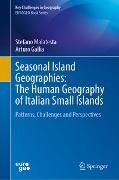Read more
The geography of the Italian small islands archipelagos is shaped by a very high level of geophysical, landscape, demographic and cultural diversity. Excluding the Venetian lagoon, a case markedly distinct within the national panorama, Italy counts almost sixty inhabited islands, temporarily or permanently populated, distributed from the Adriatic-Ionian basin to a few dozen miles off the Tunisian coast. This heterogeneity makes Italian small islands, along with Dalmatia and the Aegean islands, a key region to understanding the human geography of the Mediterranean.
This book points to the overarching interpretative category we will use in developing the description and analyses of Italian small islands geographies: temporality. As Peter Haggett suggested in his celebrated introduction to the concepts of human geography (the geography of the beach), our discipline deals with the humanization of spaces always taking into account the role of time as the variable through which this action takes shape. This double layer is fundamental to understand the human geography of micro-island systems. The book stresses key elements of the human geography of Italian islands (tourism, energy production, demography, connectivity, and administrative geography) by placing “seasonal politics” at the centre of the analysis. That is, the idea that the humanisation of space is strongly linked to the recursive nature of the seasons: the so-called “one-peak seasonality” (both climatic and human) that govern the set of social, cultural and economic activities framing small islands’ human geographies. This recursive seasonality becomes, the key to understanding the territorial, environmental and social policies of the Italian archipelagos. The book combines cartographic, statistical and historical sources with descriptions and insights into specific cases. The chapters frame the human geography of the Italian islands in the broader scenario of environmental and territorial policies on regional, national and European scales. Researchers in geography, social sciences, environmental sciences, economics, architecture and political science are the key audience of the book. In addition, practitioners, decision-makers and master's students may be interested in reading the volume.
List of contents
Italian Small Islands.- Theoretical and interpretive keys.- The regional framework.- A focus on the Mediterranean.
Summary
The geography of the Italian small islands archipelagos is shaped by a very high level of geophysical, landscape, demographic and cultural diversity. Excluding the Venetian lagoon, a case markedly distinct within the national panorama, Italy counts almost sixty inhabited islands, temporarily or permanently populated, distributed from the Adriatic-Ionian basin to a few dozen miles off the Tunisian coast. This heterogeneity makes Italian small islands, along with Dalmatia and the Aegean islands, a key region to understanding the human geography of the Mediterranean.
This book points to the overarching interpretative category we will use in developing the description and analyses of Italian small islands geographies: temporality. As Peter Haggett suggested in his celebrated introduction to the concepts of human geography (the geography of the beach), our discipline deals with the humanization of spaces always taking into account the role of time as the variable through which this action takes shape. This double layer is fundamental to understand the human geography of micro-island systems. The book stresses key elements of the human geography of Italian islands (tourism, energy production, demography, connectivity, and administrative geography) by placing “seasonal politics” at the centre of the analysis. That is, the idea that the humanisation of space is strongly linked to the recursive nature of the seasons: the so-called “one-peak seasonality” (both climatic and human) that govern the set of social, cultural and economic activities framing small islands’ human geographies. This recursive seasonality becomes, the key to understanding the territorial, environmental and social policies of the Italian archipelagos. The book combines cartographic, statistical and historical sources with descriptions and insights into specific cases. The chapters frame the human geography of the Italian islands in the broader scenario of environmental and territorial policies on regional, national and European scales. Researchers in geography, social sciences, environmental sciences, economics, architecture and political science are the key audience of the book. In addition, practitioners, decision-makers and master's students may be interested in reading the volume.

